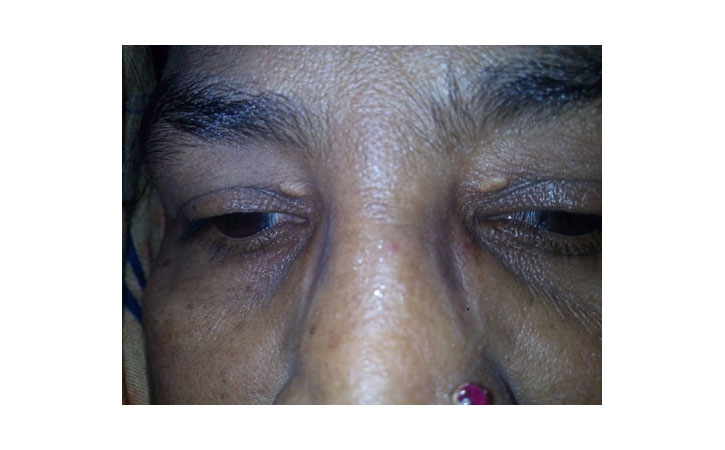Xanthelasma
The term xanthelasma is derived from the Greek xanthos (yellow) and elasma (beaten metal plate). Xanthelasma are yellowish plaques that occur most commonly near the inner canthus of the eyelid, more often on the upper lid than the lower lid. Xanthelasma palpebrarum is the most common cutaneous xanthoma.
Xanthelasma can be soft, yellowish, fatty deposit, semisolid, or calcareous. Frequently, they are symmetrical. The upper lids are more frequently involved than the lower lids. Often, 4 lids are involved. Xanthelasma have a tendency to progress, coalesce, and become permanent. It’s not harmful, but in rare cases it may be an indicator of possible heart disease. It’s seen more who’s from Asia or the Mediterranean.

Xanthelasma are yellowish-white lumps of fatty material, soft, semisolid, or calcareous accumulated under the skin on the inner parts of upper and lower eyelids. The plaques contain lipids, or fats, including cholesterol, and usually appear symmetrically between eyes and nose.
About half the people with xanthelasma have high cholesterol(60-70% of patient). Causes are:
- High LDL cholesterol or low HDL cholesterol,
- Inherited high cholesterol,
- Liver disease called primary biliary cirrhosis, which can raise cholesterol levels.
Numerous options are available for the removal of xanthelasma palpebrarum, including surgical excision, argon and carbon dioxide laser ablation, chemical cauterization, electrodesiccation, and cryotherapy. Most of the time, xanthelasma is completely harmless, but may still want to have it removed. There are a number of treatment options available:
Cryotherapy: This involves freezing the xanthelasma with liquid nitrogen or another chemical.
Laser surgery: One type of laser technique, known as fractional CO2,
Surgery: The surgeon will remove the xanthelasma by surgical procedure.
Radiofrequency advanced electrolysis: It is use to eliminating or reducing xanthelasma.
Chemical peels: Treatment with tricholoroacetic acid (TCA) experienced satisfactory.
Medication: The statin drug: simvastatin may treat xanthelasma.
Xanthelasma may reappear after treatment.
Managing cholesterol
Lowering cholesterol may also help treat the xanthelasma. For some people, changes to diet and lifestyle choices may be enough to manage cholesterol. To lower cholesterol:
- avoid smoking,
- maintain a healthy weight,
- exercise at least 30 minutes most days of the week,
- limit consumption of saturated fats, which are found in things like butter.
If anyone needs to remove xanthelasma, then need to consult with a doctor. To check up cholesterol level and start statins or another medication, need to visit a doctor. There are also some natural remedies that may work, but talk to doctor before using supplements or alternative treatments for cholesterol.
- Roxburgh’s common skin diseases
- Andrew’s Diseases of the skin
Xanthelasma
TUI - Tibot Urgency Index


The term xanthelasma is derived from the Greek xanthos (yellow) and elasma (beaten metal plate). Xanthelasma are yellowish plaques that occur most commonly near the inner canthus of the eyelid, more often on the upper lid than the lower lid. Xanthelasma palpebrarum is the most common cutaneous xanthoma.
Xanthelasma can be soft, yellowish, fatty deposit, semisolid, or calcareous. Frequently, they are symmetrical. The upper lids are more frequently involved than the lower lids. Often, 4 lids are involved. Xanthelasma have a tendency to progress, coalesce, and become permanent. It’s not harmful, but in rare cases it may be an indicator of possible heart disease. It’s seen more who’s from Asia or the Mediterranean.



Xanthelasma are yellowish-white lumps of fatty material, soft, semisolid, or calcareous accumulated under the skin on the inner parts of upper and lower eyelids. The plaques contain lipids, or fats, including cholesterol, and usually appear symmetrically between eyes and nose.
About half the people with xanthelasma have high cholesterol(60-70% of patient). Causes are:
- High LDL cholesterol or low HDL cholesterol,
- Inherited high cholesterol,
- Liver disease called primary biliary cirrhosis, which can raise cholesterol levels.
Numerous options are available for the removal of xanthelasma palpebrarum, including surgical excision, argon and carbon dioxide laser ablation, chemical cauterization, electrodesiccation, and cryotherapy. Most of the time, xanthelasma is completely harmless, but may still want to have it removed. There are a number of treatment options available:
Cryotherapy: This involves freezing the xanthelasma with liquid nitrogen or another chemical.
Laser surgery: One type of laser technique, known as fractional CO2,
Surgery: The surgeon will remove the xanthelasma by surgical procedure.
Radiofrequency advanced electrolysis: It is use to eliminating or reducing xanthelasma.
Chemical peels: Treatment with tricholoroacetic acid (TCA) experienced satisfactory.
Medication: The statin drug: simvastatin may treat xanthelasma.
Xanthelasma may reappear after treatment.
Managing cholesterol
Lowering cholesterol may also help treat the xanthelasma. For some people, changes to diet and lifestyle choices may be enough to manage cholesterol. To lower cholesterol:
- avoid smoking,
- maintain a healthy weight,
- exercise at least 30 minutes most days of the week,
- limit consumption of saturated fats, which are found in things like butter.
If anyone needs to remove xanthelasma, then need to consult with a doctor. To check up cholesterol level and start statins or another medication, need to visit a doctor. There are also some natural remedies that may work, but talk to doctor before using supplements or alternative treatments for cholesterol.
- Roxburgh’s common skin diseases
- Andrew’s Diseases of the skin




